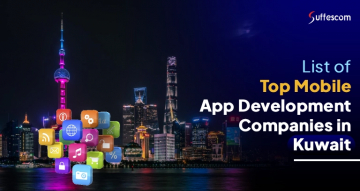How Much Does It Cost to Develop a Fitness App in 2026?

In today's health-conscious world, fitness apps are becoming increasingly popular. They cater to users looking to achieve their fitness goals conveniently and efficiently. Did you know? Revenue in the fitness apps market is projected to reach US$6.86bn in 2024. It is expected to show an annual growth rate (CAGR 2024-2029) of 7.96%, resulting in a projected market volume of US$10.06bn by 2029. As a result, many entrepreneurs and fitness enthusiasts are eager to dive into fitness app development.
However, one pressing question looms: How much does it cost to develop a white label fitness app?
Understanding the costs associated with fitness app development is essential for anyone considering this venture. This blog will break down the factors affecting development costs, the vital components of fitness apps, and the various types available. We will also explore how these apps benefit end-users, staff, and gym owners. Finally, we’ll highlight why hiring a reputable fitness app development company like Suffescom can lead to successful app outcomes.
Want to Reduce the Cost to Develop a Fitness App?
Save 70% on the app development costs with Suffescom Solutions.
Factors Affecting The Development Cost of Fitness App
The cost to develop a fitness application can vary significantly based on several factors. Here are the key elements that affect the cost of fitness app development:
1. App Complexity
The cost of development depends on the complexity of your app. A simple fitness tracker will naturally cost less to develop. But a comprehensive app with advanced analytics and personalized workout plans can cost more.
2. Features and Functionality
The more features you want to include, the higher the cost. Basic features like user registration and workout tracking will cost less. Whereas, advanced features such as social sharing or personalized coaching can increase spending.
3. Platform Choice
The platform that you select for the app can affect the development costs. Building an app for iOS or Android requires less cost. But developing app for various platforms can increase the budget.
4. Design and User Experience
A fitness app with an engaging design can keep users on the app for longer. An advanced UI/UX design can make your app appealing but it can also add to the costs.
5. Backend Development
Technologies used for developing the app’s backend can affect the fitness app development cost. Backend development is vital for handling user data and tracking workouts. It can take more time and money to create a well-designed backend with the latest technologies.
6. Geographical Location of Development Team
The location of your development team plays a significant role in the cost. Developers in North America generally charge more than those in Eastern Europe or Asia. However, the quality of work can also vary based on location.
7. Maintenance and Updates
Regular maintenance is essential to keep the app running smoothly and meet the user requirements. Preparing a budget is crucial to meet the costs for the app’s maintenance and updates.
8. Marketing and Promotion
Marketing your fitness app is vital for its success. Spending money to promote the app can help bring more users and increase revenue.
Must-Have Features for Fitness Apps

Let’s explore the features that a fitness app should have for enhancing the user experience:
1. Registration of Users
Creating user profiles allows individuals to track their fitness journey. Users can input personal details such as age, weight, height, and fitness goals, providing a customized experience.
2. Workout Tracking
This feature enables users to log their workouts, monitor progress, and adjust their routines accordingly. It may include options for tracking various types of exercises, durations, and calories burned.
3. Nutrition Tracking
Many fitness apps incorporate nutrition tracking to help users manage their dietary habits. This feature can include meal logging, calorie counting, and personalized meal plans.
4. Progress Analytics
Integrating analytics allows users to visualize their progress over time. Graphs and charts can help users understand trends in their workouts, weight loss, and overall health.
Integrating analytics enables users to visualize their progress over time. Graphs and charts can help users understand trends in their workouts, weight loss, and overall health.
5. Social Features
Social sharing options can enhance user engagement. Features such as leaderboards, challenges, and community forums foster motivation and accountability among users.
6. Integration with Wearable Devices
Many fitness enthusiasts use wearable devices to track their activities. Integrating your app with smartwatches can enhance user experience and data accuracy.
7. Personalized Coaching
Offering personalized coaching through virtual trainers can make your app stand out. This feature may include video tutorials, tailored workout plans, and feedback based on your performance.
8. In-app Purchases and Subscriptions
Monetization strategies, like in-app purchases and subscription models, can generate revenue. This allows users to access premium features, workout plans, or personalized coaching.
Want to Build a Next-Gen Fitness App like MyFitnessPal?
Build a pocket-friendly fitness app with Suffescom Solutions.
How Fitness Apps Works for the End-User, Staff, and Gym Owners?
Let’s understand how fitness apps function for various stakeholders, which is essential for successful development to examine the benefits for end-users, staff, trainers, and gym owners.
For End-Users
Fitness apps empower users by providing tools to monitor their fitness journey. Users can easily set goals, log workouts, and track nutrition, all from their smartphones. The ability to analyze progress through visuals keeps users motivated and accountable. Personalized recommendations based on their data can help users make informed decisions about their fitness routines.
For Staff
Fitness app development also streamlines gym staff operations. Trainers can use the app to manage client schedules, provide personalized workout plans, and track client progress efficiently. This reduces administrative burdens and enhances client engagement. The app allows staff to send reminders, share resources, and provide feedback directly through the platform, improving communication and service quality.
For Trainers
Trainers also benefit significantly from fitness apps. They can create customized training programs tailored to individual client needs and goals, making it easier to monitor progress over time. Through the app, trainers can communicate directly with clients, offer real-time feedback, and adjust plans based on performance. This dynamic interaction enhances the trainer-client relationship and fosters accountability and motivation for clients.
For Gym Owners
Gym owners also benefit significantly from fitness apps. They can optimize their services with features like member management and performance tracking. Integrating membership systems allows for better retention and engagement with clients. Additionally, gym owners can analyze overall usage data, which provides insights into popular classes, peak times, and member preferences, enabling them to make data-driven decisions to enhance their offerings.
Also Read: Whitelabel Fitness App Solutions
How Much Does Fitness App Development Cost?
The Complexity of Fitness App
The cost of developing a fitness app depends on how complex it is. A simple app with basic design and features is less costly. But a complex app with advanced features requires a higher cost.
Estimated Cost Based on App’s Complexity
- Basic App: $10,000- $15,000
- Moderately Complex App: $15,000 - $20,000
- Advanced App: $20,000- $25,000
User Interface of the App
The app's user interface plays a key role in engaging the target audience and keeping them hooked. A basic interface is less costly. But a custom user interface with interactive design can add to the total costs.
Estimated Cost Based on the User Interface
- Basic UI/UX Design: $10,000- $20,000
- Customizable UI/UX design: $20,000- $25,000
Type of Platform
The selection of a platform, like Android and iOS, can impact the cost to develop fitness app. Building a fitness app for both Android and iOS users requires much higher spending.
Estimated Cost Based on Type of Platform
- iOS or Android: $10,000- $20,000
- Both Platforms: $20,000 - $25,000
App Testing and Maintenance
The testing stage involves monitoring the performance of the iOS or Android app and improving it by fixing issues. The development company provides continuous maintenance and support after the launch of fitness app.
Estimated Cost for App Testing & Maintenance: $5,500- $10,000
Advanced Tech Stack for Fitness App Development
The choice of a tech stack for testing and deploying a fitness app will depend on various factors, including the platform (web, mobile), the programming language used for app development, and the preferred testing and deployment tools. However, here are some usually used for fitness app development:
| Category | Technology/Tool | Description | Popular Examples |
| Operating Systems | iOS | Apple's mobile operating system is used for iPhone and iPad apps. | iOS |
| Android | Google's mobile operating system is used for various devices, including smartphones and tablets. | Android | |
| Programming Languages | iOS | Languages specifically for developing iOS applications. | Swift, Objective-C |
| Android | Languages specifically for developing Android applications | Kotlin, Java | |
| App Development Frameworks | iOS (Native) | Tools and frameworks designed specifically for iOS development. | Cocoa Touch, 3D Touch, Push Notifications, In-App Purchases, SiriKit, CallKit, CocoaPods, AFNetworking |
| Android (Native) | Tools and frameworks designed specifically for Android development. | RetroFit, Volley, Dagger2, Gradle, Glide | |
| Cross-Platform | Frameworks that allow development across multiple mobile platforms. | React Native, Flutter, Ionic | |
| Database Management Systems | SQL | Databases that use structured query language for managing data. | MySQL |
| NoSQL | Non-relational databases are designed for large-scale data storage that can handle varied data structures. | Realm, Core Data | |
| Third-Party API Services | Fitness Tracking | APIs that facilitate the integration of fitness tracking data from wearables and other sensors. | Fitbit API, Apple HealthKit, Google Fit API |
| Payment Processing | APIs to handle in-app purchases and subscriptions for premium features. | Stripe API, PayPal, Apple Pay, Google Pay | |
| Social Media Integration | APIs that allow users to connect, share achievements, and interact via social media platforms. | Facebook API, Twitter API | |
| Mapping and Location Services | APIs to incorporate mapping, routing, and location-based features essential for outdoor fitness apps. | Google Maps API, Mapbox |
Also Read - Cost to Build Fitness App Like Strava
Why Hire Suffescom for Low Fitness App Development Cost?
Choosing the right development partner is crucial for the success of your fitness app. Here’s why Suffescom stands out as an ideal choice lower your fitness app development cost:
1. Expertise in Fitness Apps
Suffescom has a proven track record in developing fitness applications. Their experience ensures a deep understanding of the market and user needs.
2. Customized Solutions
Suffescom offers tailored solutions to meet each client's specific requirements. It collaborates closely with clients to bring their visions to life.
3. Skilled Development Team
With a skilled team of developers, designers, and project managers, Suffescom guarantees high-quality work. Their expertise ensures that the app functions smoothly and looks appealing.
4. Focus on User Experience
Suffescom prioritizes user experience, ensuring the app is intuitive and easy to navigate. A seamless user experience increases retention rates and overall satisfaction.
5. Ongoing Support and Maintenance
Post-launch support is essential for the app's success. Suffescom offers ongoing maintenance and updates to ensure your app remains relevant and functional.
6. Transparent Pricing
They provide transparent pricing models, allowing clients to understand upfront costs. This helps in budget planning and avoiding hidden fees.
Take Control of Your Fitness App Development Cost!
Suffescom Solutions builds an app that fits your budget.
Build a Cost-Effective Fitness App with Suffescom Solutions!
Developing a fitness app is a promising venture in today’s health-focused society. However, understanding the fitness app development cost is crucial for success. Various factors, including app complexity, features, and platform choice, play significant roles in determining costs.
The cost of developing a fitness app varies widely based on these factors. By breaking down components and types of fitness apps, we gain insight into what to expect regarding budget. Choosing a competent development partner like Suffescom can significantly impact your app's success. With their expertise and commitment to quality, you can create an engaging fitness app that meets user needs and stands out in a competitive market.
Invest in your fitness app vision today and bring your idea to life! Remember, thorough research and planning will yield the best results for health and fitness app development.
FAQs:
1. How Much Does it Cost to Develop a Fitness App?
The cost of developing a fitness app with basic functionalities is lower. But the cost is higher for building an app that has AI features or one that integrates with wearable devices.
2. Can a Fitness App Make Money?
The earnings from a fitness app depend on the source of revenue. You can make money from advertisements, subscriptions, or purchases through the app.
3. How to Build an App like MyFitnessPal?
You can hire an app development company to build an app like MyFitnessPal. The company follows these stages to create a fitness app:
- Understands Your Business Objectives
- Does a Detailed Study of the Market
- Incorporates the Features You Want in the App
- Creates the User Interface
- Utilizes the Tech Stack for Developing the App
- Testing and Launch of the App
- Support and Maintenance of the app
4. How Long Does it Take to Build a Fitness App?
The app’s complexity can affect the time it takes to build a fitness app. A highly complex app takes more time to develop than a basic app.







